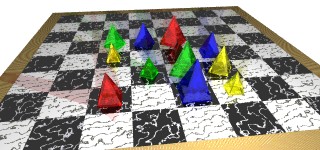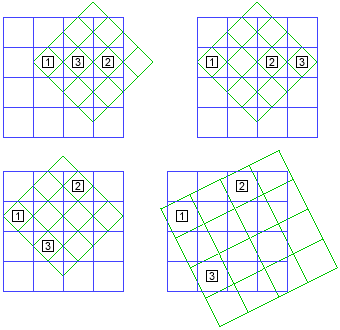 Folio
Folio 
 Folio
Folio 
Warning: Rules subject to minor tweaking.

Choose a player to take the first turn by any means desired.
The first piece must be placed on one of the four central squares of the board. Subsequent pieces may be placed on any empty square within 3 squares of all pieces already on the board, measured in any direction including diagonally. Pieces may not be placed on an occupied square. Although orientation is not important, it is recommended that pieces be placed upright. You must use the piece chosen by the other player. Once a piece has been placed, it is not moved.
The restriction on placing pieces within 3 squares of existing pieces restricts the play to a 4x4 subset of squares within the chessboard, however the exact 16 squares used are undefined until enough pieces have been placed to define the 4x4 subgrid uniquely. In other words, if all 16 pieces get played, they must form a 4x4 subgrid, with no pieces placed outside it. It may be easier to think of the restriction in these terms.
The winner is the first player to place a piece which completes a line of four pieces in any direction (horizontally, vertically, or diagonally) which contains either:
Always keep an eye on what pieces remain beside the board to be chosen, and play with this in mind. It's no good making a move which means the only piece you can give to your opponent to prevent him winning is a small green one, when there are no small green pieces left!
Be careful to watch the diagonals, especially when the 4x4 subgrid has not yet been fully defined. There may be several possible diagonal lines that can end up being winning lines.
Eight of the pieces in the game are unique, while the other eight are two copies of four different pieces. Be aware of which pieces are available twice.
 The first piece is placed in the centre of the table. The next piece is placed anywhere else, and its sides do not need to
be parallel to the first piece. (In practice, there is no point to placing the second piece more than about 6 large pyramid
sizes away from the first piece, or roughly 6 inches for standard sized Icehouse pieces. This helps keep the whole
grid on the table!) This forms two squares of the notional 4x4 grid, but which two remains undefined as yet. Note that
the notional grid does not have to be parallel to the sides of any pieces.
The first piece is placed in the centre of the table. The next piece is placed anywhere else, and its sides do not need to
be parallel to the first piece. (In practice, there is no point to placing the second piece more than about 6 large pyramid
sizes away from the first piece, or roughly 6 inches for standard sized Icehouse pieces. This helps keep the whole
grid on the table!) This forms two squares of the notional 4x4 grid, but which two remains undefined as yet. Note that
the notional grid does not have to be parallel to the sides of any pieces.
The third piece might define things better. Some possible third piece plays are shown in the diagrams with possible notional grids. Note that the size and even the orientation of the notional grid may remain undefined until more pieces are played. Future plays must conform to at least one possible notional grid. Eventually the exact grid size, placement, and orientation is uniquely determined, and play continues using that notional grid. Note that pieces are always assumed to be at or very near the centre of their notional grid squares.
If ever a player believes his opponent has placed a piece in such a way that no 4x4 notional grid can possibly accomodate all the played pieces, he may challenge his opponent to demonstrate where the grid is. If the opponent cannot show such a grid, he loses the game. If he can, the challenger loses.